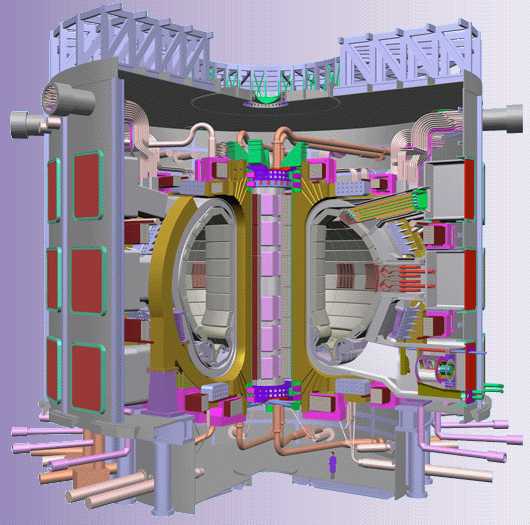|
Fusion Tutorials
What is Fusion ?
Look up in the sky on a sunny day,
and you will see the nearest fusion reactor to the earth! The goal of
controlled fusion research is to create a miniature star in the
laboratory, and to try and harness the energy that is released. Nuclear
fusion occurs all the time in the interior regions of stars. In the
process lighter nuclei fuse together to form heavier nuclei and release
tremendous amounts of energy, thus heating the interior of the star.
Since the mid-1950's a world-wide effort has been underway to
demonstrate controlled fusion in the laboratory. Reaching fusion
conditions is not easy, since it requires requires reaching temperatures
in excess of 50,000,000 deg C (!). As you might imagine, matter as we
know is ceases to exist at such high temperatures. Instead, the fusion
fuel becomes ionized (that is, the electrons and atomic nuclei are torn
apart and form an electrically conducting gas). Other places where
plasmas exist include the sun, inside flourescent and neon light bulbs,
ion rocket engines, and plasma processing devices used to etch
semiconductor materials. Since plasma is electrically conducting it can
interact with electromagnetic fields (generated by electromagnets,
microwave and radio-frequency sources, and lasers).
How are the required
conditions generated in the lab ?
Previous research has identified
two promising approaches: magnetically confined fusion, and inertially
confined fusion. The latter approach uses large, powerful lasers or
particle beams to illuminate a small target of fusion fuel and quickly
(less than a billionth of a second) reach fusion conditions. If you are
interested in learning more about this concept you may jump to the
National Ignition Facility Homepage for a more detailed discussion. The
approach advocated by the LCT research program has grown out of the
magnetically confined approach. The basic idea in this approach is to
use ... The LCT approach makes a radical departure from the traditional
magnetic tokamak in that the motion of plasma particles is no longer
governed solely by magnetic fields, but instead is governed by both
electric and magnetic fields.
Traditional Approaches to
Magnetic Fusion
A number of different
configurations for achieving fusion conditions have been proposed over
the years. Some of the more common ones include:
-
Magnetic Mirrors
-
Stellarators
-
Tokamaks Reversed
-
Field Pinch
The magnetic mirror scheme used a
linear array of magnet coils to form a "magnetic bottle". In this
scheme, the magnetic field at the ends was made much stronger than the
magnetic field in the middle of the chamber. As a result the loss rate
of plasma from the ends of the magnetic bottle is reduced. However, most
researchers today believe that this approach cannot be made to produce
net power; thus most research on this scheme has been stopped.
The
Stellarator concept was invented in the
1950's in the US, and used a complex set of coils to produce a toroidal
magnetic field (i.e. one that is shaped like a donut). In a stellarator
the magnetic fields needed to confine the plasma are all produced with
external magnet coils; thus stellarator devices can be operated in the
steady state. Large stellarator experiments are active in Germany
(W7-AS), and two new larger stellarator experiments are in the
construction stage ( the W7-X device in Germany and the superconducting
LHD device in Japan). The tokamak forms the basis of the dominant
magnetic fusion scheme in the world today. The tokamak concept also
depends upon a toroidal magnetic field. However in the tokamak a
significant plasma current exists which also plays an important role in
generating the magnetic confinement. Because of the need to sustain this
plasma current, the tokamak is usually a pulsed device (although
techniques for making it into a steady device are under development).
What is a Tokamak?
A tokamak is a toroidal plasma confinement device
invented in the 1950s by the Russians Tamm and Sakharov (yes, the famous
one). The word "tokamak" is a contraction of the Russian words:
"toroidalnaya", "kamera", and "magnitnaya", meaning "toroidal
chamber-magnetic." The plasma is confined here not by the material walls
(which wouldn't be compatible with a plasma which will be millions of
degrees Celsius), but by magnetic fields. Physicists have been working
since the 1950s on making better "magnetic bottles," a problem which has
been compared to holding jello (the plasma) with rubber bands (the
magnetic field).
The magnetic fields in a tokamak are produced by a
combination of currents flowing in external coils and currents flowing
within the plasma itself.
This contrasts to a similar concept, the
stellarator, in which all of the confining magnetic fields are produced by
external coils.

Home
Research Area
Faculty staff students
Physics Resources
About
us
|
